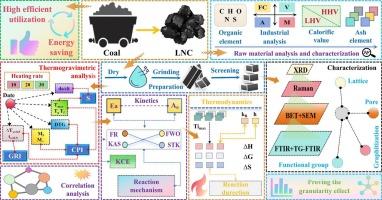低阶多颗粒煤的动力学和热力学分析:粒度对反应性和焦炭性质的协同效应
IF 7.5
1区 工程技术
Q2 ENERGY & FUELS
引用次数: 0
摘要
本研究对粒径范围为40-80目、80-150目和150-300目的低阶无粘结多颗粒煤(LNC)样品进行了动力学和热力学分析。研究了多颗粒LNC在CO2气氛下的热解焦收率及其反应特性。结合表征技术(BET、SEM、XRD、Raman和FTIR)和Friedman、Kissinger-Akahira-Sunose、Flynn-Wall-Ozawa和Starink方法,研究了粒度和焦炭性质对反应性的协同效应。结果表明,减小颗粒尺寸可显著提高煤样的比表面积和孔隙体积。随着热解温度的升高,焦炭产率从300℃时的91.2 ~ 93.64 wt%下降到900℃时的64.8 ~ 66.92 wt%。细粒样品的产率略低,因为它们经历了更彻底的挥发。在相同温度下,细粒(150 ~ 300目)样品的ID/IG值明显高于粗粒样品,且表现出更强的反应活性。其气化反应指数(GRI)、综合热解指数(CPI)和综合气化特征指数(S)值分别比粗粒煤(40 ~ 80目)高0.77%、20.21%和31.36%。动力学分析表明,细晶样品的平均活化能(Ea)为169.19 kJ/mol,明显低于粗晶样品。反应机制以扩散和成核为主,ΔH、ΔG和ΔS证实细粒样品反应性更强。该研究为低阶煤分级利用过程中优化粒度,调节焦炭产量,实现CO2的大规模应用提供了指导。本文章由计算机程序翻译,如有差异,请以英文原文为准。

Kinetic and thermodynamic analyses of multigranular low-rank coal: Synergistic effect of particle size on reactivity and coke properties
This study performed kinetic and thermodynamic analyses on samples of multigranular low-rank unbound coal (LNC) with three different particle size ranges: 40–80 mesh, 80–150 mesh, and 150–300 mesh. The study investigated the pyrolytic coke yield of multigranular LNC and its reaction characteristics under a CO2 atmosphere. The synergistic effect of particle size and coke properties on the reactivity was highlighted using a combination of characterization techniques (BET, SEM, XRD, Raman, and FTIR) and the Friedman, Kissinger-Akahira-Sunose, Flynn-Wall-Ozawa, and Starink methods. The results showed that reducing the particle size significantly increased the specific surface area and pore volume of the coal samples. Upon increasing the pyrolysis temperature, the coke yield decreased from 91.2–93.64 wt% at 300 °C to 64.8–66.92 wt% at 900 °C. The fine-grained samples had slightly lower yields because they underwent more thorough volatilization. At the same temperature, the ID/IG values of the fine-grained samples (150–300 mesh) were significantly higher than those of the coarse-grained samples, and they also exhibited greater reactivity. Their gasification reaction index (GRI), comprehensive pyrolysis index (CPI), and comprehensive gasification characteristic index (S) values were respectively 0.77 %, 20.21 %, and 31.36 % higher than those of the coarse-grained samples (40–80 mesh). The kinetic analysis indicated that the average activation energy (Ea) of the fine-grained samples was 169.19 kJ/mol, which was significantly lower than that of the coarse-grained samples. The reaction mechanism was dominated by diffusion and nucleation, and ΔH, ΔG, and ΔS confirmed that the fine-grained samples were more reactive. This study provides guidance for optimizing the particle size during the classification and utilization of low-rank coal to regulate the coke yield for the large-scale application of CO2.
求助全文
通过发布文献求助,成功后即可免费获取论文全文。
去求助
来源期刊

Fuel
工程技术-工程:化工
CiteScore
12.80
自引率
20.30%
发文量
3506
审稿时长
64 days
期刊介绍:
The exploration of energy sources remains a critical matter of study. For the past nine decades, fuel has consistently held the forefront in primary research efforts within the field of energy science. This area of investigation encompasses a wide range of subjects, with a particular emphasis on emerging concerns like environmental factors and pollution.
 求助内容:
求助内容: 应助结果提醒方式:
应助结果提醒方式:


